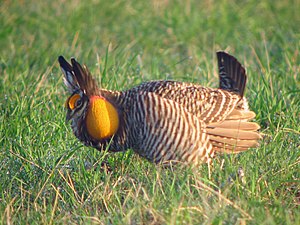Prairie chicken
| Prairie chicken | ||||||||||||
|---|---|---|---|---|---|---|---|---|---|---|---|---|

Prairie chicken ♂ ( Tympanuchus cupido ) |
||||||||||||
| Systematics | ||||||||||||
|
||||||||||||
| Scientific name | ||||||||||||
| Tympanuchus cupido | ||||||||||||
| ( Linnaeus , 1758) |
The prairie chicken ( Tympanuchus cupido ) is a species of bird from the subfamily of grouse that occurs in North America . It is one of the endangered species .
features
The 40-47 cm large prairie chicken has a brown-black striped body. The wings also have light bands. The underside is striped lighter and wider. The wings are gray, the edges of the fan-shaped tail are dark brown in color. The prairie chicken is bulky and, like all grouse, has feathered legs and toes. The male has two long feathers on the back of the head. There is a red-orange outgrowth above the eyes. The throat and cheeks are light, the rest of the head is dark brown. Two large, yellow-orange air sacs are covered by brown, in one subspecies also black feathers. During courtship these are inflated.
The female is overall lighter, therefore less conspicuous and instead of the forelock only has a small collar, similar to that of the collar hen. The animal has a black eye stripe; Throat, cheeks are beige. The female also has air sacs, but much smaller. The thin beak is always brown. The female weighs 770–1020 grams, the male is significantly heavier with 990–1360 grams.
distribution
The prairie chicken was once abundant in the prairie regions east of the Rocky Mountains . Due to hunting and loss of habitat due to the conversion of prairie areas into agricultural land, the population is falling sharply. The prairie chicken does benefit from the expanded food supply that agricultural land offers it. For nest building and the rearing of chicks, however, it is imperative to rely on prairie prairie.
Today it only occurs in the central United States , with distribution focuses in the states of Nebraska , Oklahoma and South Dakota , where it competes with the pheasant released . The males stay in their mating grounds even in winter, the females migrate south.
Subspecies
In addition to the nominate form, there are two subspecies:
- Great prairie chicken ( T. c. Pinnatus )
- Attwateri prairie chicken ( T. c. Attwateri )
The nominate form, the heather grouse ( T. c. Cupido ), became extinct at the beginning of the 1930s. The heather grouse was found in the bush-covered, barren heaths of the coastal region of New England , from the southernmost tip of New Hampshire to northern Virginia , and was hunted intensively by the first European settlers, which ultimately led to the population collapse. The heather chicken could also have been a species of its own. This means that the other two subspecies would also belong to one species ( T. pinnatus ).
The prairie chicken ( T. pallidicinctus ) used to be classified here as a fourth subspecies.
Way of life
food
The prairie chicken used to feed on seeds, grasses and shoots. By converting it to pastureland, the prairie grasses became rare and the species had to switch to man-made crops such as soy and wheat . In winter, prairie chickens mainly eat buds, hazelnuts and acorns.
Reproduction
During courtship, the males occupy arenas that they defend against other males. The animals often use the same courtship grounds for years. The prairie chickens perform a characteristic courtship dance: They set up their feathers and tail so that the white lower plumage is visible, inflate the air sacs and turn in a circle while stamping their feet on the ground. They emit howling, dull noises that sound like someone blowing over the opening of a glass bottle. The animals always take a horizontal posture and tilt their heads to the ground. Because of this "Indian dance" they are a popular fowl.
The female lays the 8–12 light brown, speckled eggs in a hollow. The breeding season lasts 25 days, only the female takes care of the initially yellow-brown young. They are only fed insects , especially grasshoppers . The young birds stay with their mother for 6–8 weeks.
Web links
- Description of the prairie chicken
- Short description
- Prairie Chicken at www.tierdoku.com, accessed August 22, 2016
- Tympanuchus cupido in the Red List of Endangered Species of the IUCN 2013.1. Listed by: BirdLife International, 2012. Retrieved September 30, 2013.
literature
- Brehm's new animal encyclopedia , Volume 7. Herder, Freiburg im Breisgau. Special edition for Prisma Verlag, Gütersloh 1982
- Christopher S. Smith: Field Guide to Upland Birds and Waterfowl . Wilderness Adventure Press, Belgrade (Montana) 2000, ISBN 1-885106-20-3
- Bernhard Grzimek: Grzimeks animal life. Volume 7-9 birds. Deutscher Taschenbuch Verlag GmbH & Co. KG Munich (1993) ISBN 3-423-05970-2
- Fotolulu: All birds of the world: The complete checklist of all species and subspecies, Publisher: Books on Demand (2015) ISBN 3734744075
Individual evidence
- ^ Paul A. Johnsgard: Great Wildlife of the Great Plains . University Press of Kansas, 2003, ISBN 0-7006-1224-6 , p. 19
- ^ Paul A. Johnsgard: Great Wildlife of the Great Plains . University Press of Kansas, 2003, ISBN 0-7006-1224-6 , p. 19


